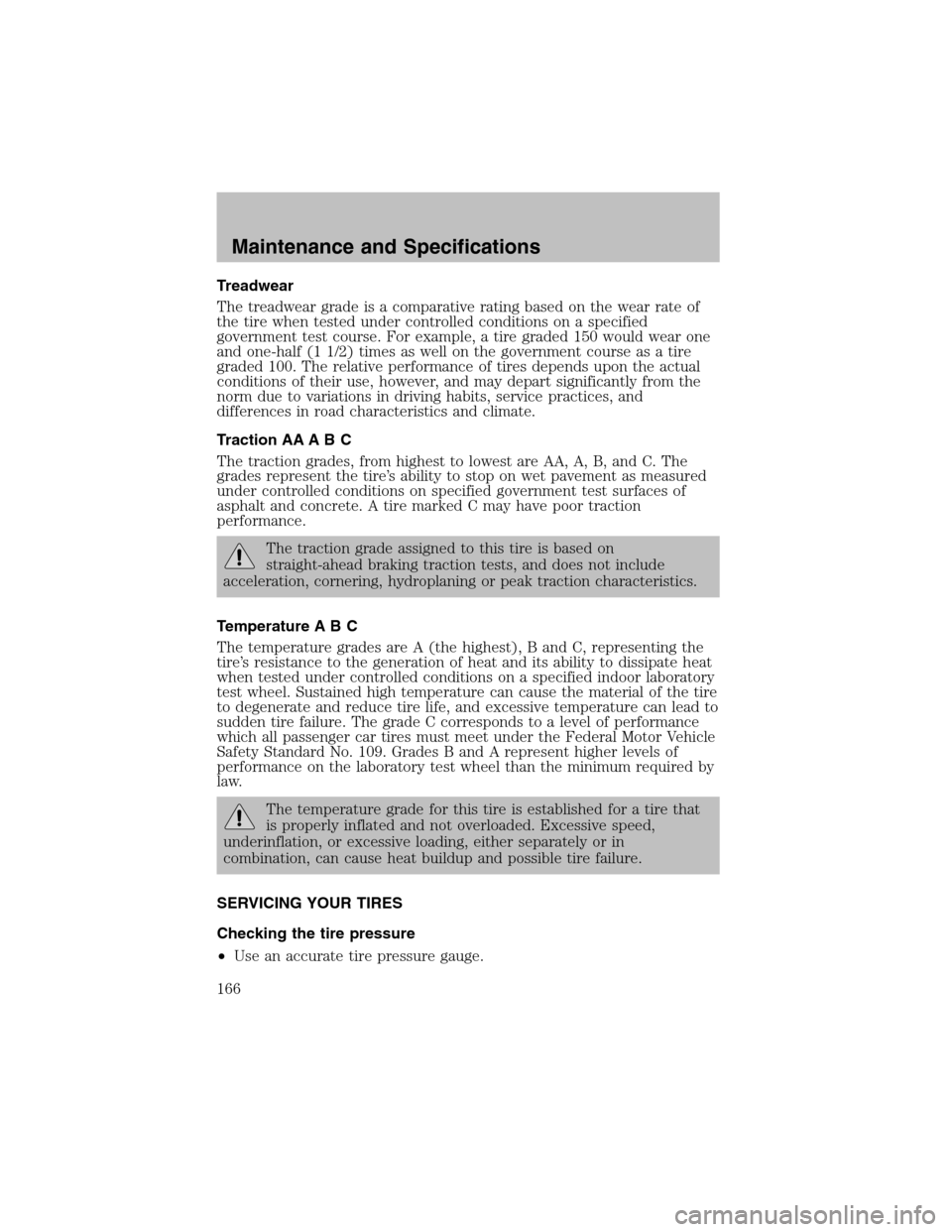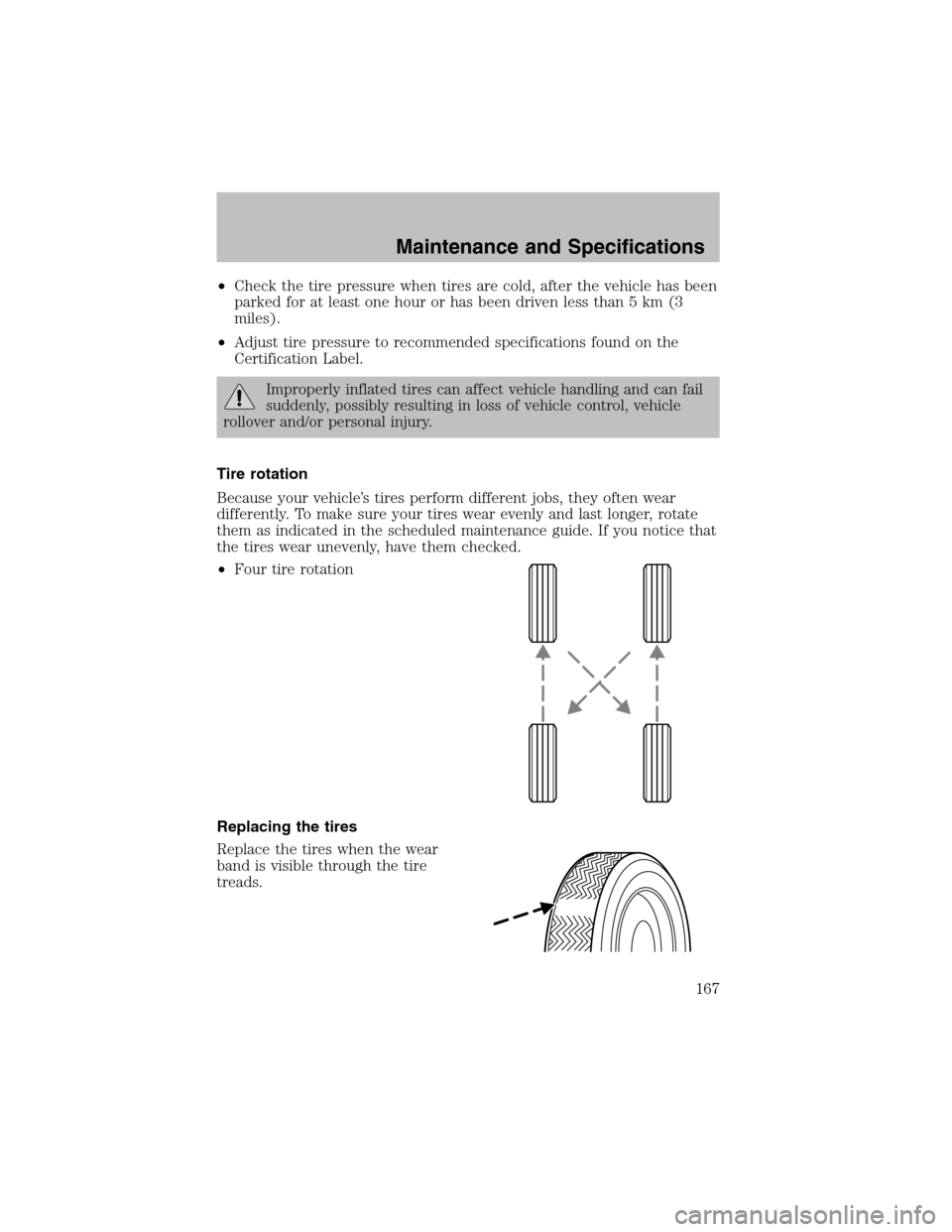tire pressure FORD ESCORT 2003 7.G Owners Manual
[x] Cancel search | Manufacturer: FORD, Model Year: 2003, Model line: ESCORT, Model: FORD ESCORT 2003 7.GPages: 184, PDF Size: 1.28 MB
Page 131 of 184

PAINTCHIPS
Your dealer has touch-up paint and sprays to match your vehicle’s color.
Take your color code (printed on a sticker in the driver’s door jam) to
your dealer to ensure you get the correct color.
•Remove particles such as bird droppings, tree sap, insect deposits, tar
spots, road salt and industrial fallout before repairing paint chips.
•Always read the instructions before using the products.
ALUMINUM WHEELS AND WHEEL COVERS
Aluminum wheels and wheel covers are coated with a clearcoat paint
finish. In order to maintain their shine:
•Clean weekly with Motorcraft Wheel and Tire Cleaner (ZC-37–A),
which is available fromyour dealer. Heavy dirt and brake dust
accumulation may require agitation with a sponge. Rinse thoroughly
with a strong streamof water.
•Never apply any cleaning chemical to hot or warm wheel rims or
covers.
•Some automatic car washes may cause damage to the finish on your
wheel rims or covers. Chemical-strength cleaners, or cleaning
chemicals, in combination with brush agitation to remove brake dust
and dirt, could wear away the clearcoat finish over time.
•Do not use hydrofluoric acid-based or high caustic-based wheel
cleaners, steel wool, fuels or strong household detergent.
•To remove tar and grease, use Ford Extra Strength Tar and Road Oil
Removal (B7A-19520–AA), available from your dealer.
ENGINE
Engines are more efficient when they are clean because grease and dirt
buildup keep the engine warmer than normal. When washing:
•Take care when using a power washer to clean the engine. The
high-pressure fluid could penetrate the sealed parts and cause
damage.
•Do not spray a hot engine with cold water to avoid cracking the
engine block or other engine components.
•Spray Motorcraft Engine Shampoo and Degreaser (ZC-20) on all parts
that require cleaning and pressure rinse clean.
Cleaning
131
Page 166 of 184

Treadwear
The treadwear grade is a comparative rating based on the wear rate of
the tire when tested under controlled conditions on a specified
government test course. For example, a tire graded 150 would wear one
and one-half (1 1/2) times as well on the government course as a tire
graded 100. The relative performance of tires depends upon the actual
conditions of their use, however, and may depart significantly from the
normdue to variations in driving habits, service practices, and
differences in road characteristics and climate.
Traction AA A B C
The traction grades, fromhighest to lowest are AA, A, B, and C. The
grades represent the tire’s ability to stop on wet pavement as measured
under controlled conditions on specified government test surfaces of
asphalt and concrete. A tire marked C may have poor traction
performance.
The traction grade assigned to this tire is based on
straight-ahead braking traction tests, and does not include
acceleration, cornering, hydroplaning or peak traction characteristics.
Temperature A B C
The temperature grades are A (the highest), B and C, representing the
tire’s resistance to the generation of heat and its ability to dissipate heat
when tested under controlled conditions on a specified indoor laboratory
test wheel. Sustained high temperature can cause the material of the tire
to degenerate and reduce tire life, and excessive temperature can lead to
sudden tire failure. The grade C corresponds to a level of performance
which all passenger car tires must meet under the Federal Motor Vehicle
Safety Standard No. 109. Grades B and A represent higher levels of
performance on the laboratory test wheel than the minimum required by
law.
The temperature grade for this tire is established for a tire that
is properly inflated and not overloaded. Excessive speed,
underinflation, or excessive loading, either separately or in
combination, can cause heat buildup and possible tire failure.
SERVICING YOUR TIRES
Checking the tire pressure
•Use an accurate tire pressure gauge.
Maintenance and Specifications
166
Page 167 of 184

•Check the tire pressure when tires are cold, after the vehicle has been
parked for at least one hour or has been driven less than 5 km(3
miles).
•Adjust tire pressure to recommended specifications found on the
Certification Label.
Improperly inflated tires can affect vehicle handling and can fail
suddenly, possibly resulting in loss of vehicle control, vehicle
rollover and/or personal injury.
Tire rotation
Because your vehicle’s tires performdifferent jobs, they often wear
differently. To make sure your tires wear evenly and last longer, rotate
themas indicated in the scheduled maintenance guide. If you notice that
the tires wear unevenly, have themchecked.
•Four tire rotation
Replacing the tires
Replace the tires when the wear
band is visible through the tire
treads.
Maintenance and Specifications
167
Page 183 of 184

Spare tire (see Changing the
Tire) ...........................................110
Spark plugs, specifications ......169,
172
Specification chart,
lubricants ...........................171–172
Speed control ..............................45
Starting your vehicle ......84–85, 87
jump starting ..........................114
Steering wheel
controls ......................................44
tilting .........................................44
T
Temperature control
(see Climate control) .................28
Tires ...........................110, 165–166
changing ..........................110–111
checking the pressure ............166
replacing ..................................167
rotating ....................................167
snow tires and chains ............168
tire grades ...............................166
treadwear ................................166
Towing .......................................100
trailer towing ..........................100
wrecker ....................................119
Transaxle
fluid, refill capacities ..............170
lubricant specifications ..........172
Transmission
automatic operation .................91fluid, checking and adding
(automatic) .............................161
fluid, checking and adding
(manual) .................................164
lubricant specifications ..........171
manual operation ......................97
Trunk ...........................................51
remote release ....................49, 54
Turn signal ..................................36
V
Vehicle dimensions ...................172
Vehicle Identification Number
(VIN) ..........................................174
Vehicle loading ............................99
Ventilating your vehicle .............88
W
Warning lights (see Lights) .......10
Washer fluid ..............................141
Water, Driving through ...............98
Windows
power .........................................44
Windshield washer fluid and
wipers
checking and adding fluid .....141
operation ...................................43
replacing wiper blades .............44
Wrecker towing .........................119
Index
183